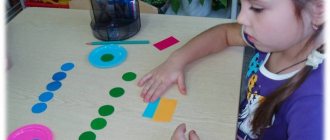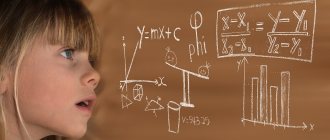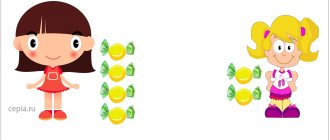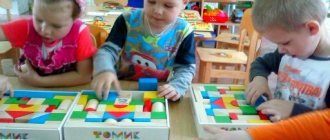In order for a 6-year-old child to develop himself in the field of mathematics, it is necessary to correctly prepare the task for him. Here it would be good to know the child’s temperament and feel his character. You should also be prepared for the fact that you need to start teaching your child from the very basics. It is advisable that a 6-year-old child has already learned to count to 20. And can solve simple mathematical problems with numbers up to 10. The child also needs to develop an understanding of the calculations “addition”, “subtraction”, “more-less-equal”. By age 7, children can already count and compare tens. You can test your child’s knowledge and expand his mathematical knowledge at home; here are examples of tasks in pictures for 6-year-old children in mathematics.
Learning to count
Exact counting: for the child, how many footballs, basketballs, handballs, and tennis balls are there in the picture. And if your son or daughter doesn’t know a certain sport, be sure to tell them and find pictures on this topic. Expand your horizons.
Counting to 20: count from 1 to 20. Say each number out loud and point with your finger to find out where the magic path leads. Look, what number comes after 12? Which one precedes 17? What numbers are between 13 and 16, 17 and 19?
Explain that a number, when written, can have one digit (single digit number) or two digits (double digit number). To learn how to count quickly, you need to learn the names of numbers from 1 to 20 and the names of tens. And in the future, simply add to the tens the numbers already familiar to you from 1 to 9.
It is important, when teaching a child to count to 30 and beyond, to pay attention and correctly name the previous and subsequent numbers in a series.
Counting to 30: count, moving your finger, from 1 to 30. Look, what number comes after 20? What number comes before 28?
Learning tens: when there are few objects, we can count them one by one 1-10. But if there are a lot of objects, it is more convenient to count by tens, which means combining them into groups of 10. If there are 10 apples in a pile, that’s 1 dozen, and if there are 2 times 10 apples, that is, 20 apples are 2 dozen.
Methods of teaching older preschoolers
Cards with numbers
Cards are a real salvation for parents: with their help you can teach your child letters and numbers, develop his memory, attention and logic.
Particularly skillful parents will play out entire performances with cards and explain the most complex mathematical operations: subtraction, addition, division and multiplication.
You can make math cards yourself.
It is better to make two sets of cards (you will keep one and give the second to your child). Next, you ask your child to find a pair for the card you took out and name the number (development of attentiveness). Or put all the cards together, inviting your child to find identical pairs (memory development).
It is best to use a combined method
Coloring pages
Coloring books have always attracted the attention of kids because you can do whatever your heart desires with them. That is why one cannot ignore the wonderful opportunity to use this property when teaching a child mathematics.
Mathematical coloring books – book for children 5-6 years old
Try to choose coloring pages according to your child's preferences and gender.
The baby will be interested in coloring pictures with cute animals, and not with creepy monsters, and the boy will quickly get bored with coloring princesses.
Copybooks
If you feel that your baby is extremely unsure of writing numbers and has difficulty making numbers from them, then print out several different copybooks, offering your baby one of them to choose from every day.
Mathematical copybooks are sold in stationery stores
By tracing and drawing numbers, the baby will not only gradually memorize them, but will also develop fine motor skills, write much more accurately and get used to holding a pen or pencil correctly in his hand.
Choose captions that make it interesting for the child to complete the specified tasks (for example, you can choose captions with funny cartoon characters who will tell the child the task). Besides. in this case, it will always be possible to justify the child’s failure by the failure of the character (for example: “Look, your bear drew the six incorrectly! Let’s help him correct his mistake?”).
Geometric problem “count the shapes”
Connect the dots
Drawing with dots is a favorite pastime for kids. But how can you make this game useful for a child learning numbers and numbers?
Everything is very simple: we give each point its own serial number and invite the child to connect all the numbers in order, thus obtaining a beautiful picture, which can then be carefully colored (in this way we additionally train accuracy and fine motor skills - extremely important qualities for a preschooler).
Drawing by dots - pictures with a mathematical bias
If the child easily copes with the task, make it more difficult by asking the child to connect the dots in reverse order (that is, from the largest number to the smallest). Counting backwards training is a very important activity that is designed to develop the left hemisphere of the brain.
Development of attentiveness in the task “Find the difference”
Puzzles
This game is intended for kids who are just getting acquainted with numbers. It will help them remember the correct order of numbers and their symbols.
Mathematical puzzles will help you quickly learn how to navigate numbers.
Take any picture that will arouse your child’s interest (for example, boys will like a picture with brave robots, and a girl will like a picture with her favorite princesses) - it is better to take a large format picture so that the child does not get confused - then cut the picture into 9 vertical stripes and glue (or draw) a number (from 1 to 9) to each strip. To prevent the picture from becoming wrinkled during classes, it is better to laminate it (this can be done at home using transparent tape).
The process of assembling puzzles is very exciting
Next, the child, who already knows how to assemble puzzles (usually children learn this at 2-3 years old), will assemble the picture in a matter of minutes. After that, draw his attention to the numbers and invite him to name them.
Do a regular attention exercise: ask your child to turn away and swap the stripes, and then ask if the picture is correct.
If the child gives a negative answer, ask him which numbers are incorrect (it is important that the child focuses not only on the parts of the picture, but also on the order of the numbers).
Dice
Even with such a seemingly unnecessary thing, you can arrange a wonderful game for practicing counting: take a dice and any coloring picture. Next, write a number from 1 to 6 on each element. The kid will throw the die and paint over one number that comes out. This way you will not only practice counting, but also check your baby’s level of attentiveness and fatigue. If the child completes the task very quickly, complicate the task by adding another die (thus, the coloring page will contain numbers from 2 to 12).
Dice can be used as a teaching aid
Workbooks
Such notebooks are already recommended for schoolchildren, since mathematics for children 6-7 years old usually does not include a large number of pictures (unlike manuals for preschoolers, literally full of bright drawings that attract children's attention), replacing them with examples as much as possible.
Workbook for preschoolers - page with tasks
If you think that your child will be able to cope with the task without pictures that attract attention, then the notebook will be an extremely convenient option for you: it is compact and contains a large number of tasks. and also has control blocks. with which you can check whether your child has mastered a particular topic, or whether you need to repeat the material.
Walks
Once you have learned the numbers, you can begin what are called “number walks.” They can be held at any time of the year - the main thing is that during the walk you can train forward and backward counting skills.
Collecting and counting chestnuts while walking
For example, if you go for a walk in the forest, invite your child to count all the birds that he meets on his way. If you like to walk in the park, then invite your child to count all the passers-by (if the park is popular, then simplify the task: count all the men, women or children).
If you like to go on picnics in the summer, then invite your child to count the fruits in the basket, the number of plates and napkins.
Counting can be taught with anything
Remember - activities that take place in the fresh air are as productive as possible and leave behind only pleasant memories.
This is interesting!
A group of psychologists conducted a study with two control groups (in both cases, classes were held every day for an hour), the first of which studied outdoors, and the second indoors. Two months later, psychologists compared the results and found that the progress of the first group was much higher, the children quickly answered questions and behaved much more actively than their “colleagues” from the second group.
Solving problems and examples
simple examples of addition in pictures
If your 6-year-old child copes with these tasks easily, gradually make the tasks more difficult. Try subtracting.
Examples in mathematics for children 6 years old
We learn to create examples of addition and subtraction and develop logical thinking and graphic skills. Example cards can be printed.
Quests for smart people
Solve the examples, see where the boy Petya made a mistake, find the wrong answers
The first tasks for those children who have never encountered mathematical problems before in their lives must be given gradually. If your baby doesn’t even know numbers, start classes with tasks for children 3-5 years old. And you need to start with the most basic examples. This can be addition and subtraction within 5. Counting sticks are perfect for this purpose. It is necessary to present the principle of addition and subtraction in such a way that he can understand the basic essence of any mathematical operations.
However, before this, it is very important to teach your child to count to at least 10. If he has not mastered this yet, then it is too early to prepare any math assignments for him. In order for children to learn to count well, as well as subtract and add, you can prepare thematic posters that colorfully depict any objects that are close to their perception. For boys, such objects can be cars, toy soldiers, airplanes, for girls - dolls, elements from dishes, dolls or other things that they often play with.
Tasks for children whose age does not exceed 6 years must be constructed very carefully. Here, in addition to studying mathematical fundamentals, a playful form of mastering the material should also be traced. After all, if mathematics tasks are selected for them in a dry and uninteresting manner, it will be very difficult for young children, given their restlessness, to master the necessary information.
A creative approach from adults when composing mathematical problems for the youngest members of the family can be pictures that depict their children’s favorite cartoon characters. This is how you can interest a child in a math lesson and create an additional incentive for him to comprehend the basics of addition or subtraction. For example, if the picture shows the famous cartoon characters Chip and Dale. And so, through a poster, they set a task for the children: how much will it add up 2 apples that Chip has with 3 apples that Dale has? And children begin to think about how to help their favorite characters resolve their dilemma.
Of course, in order to correctly create a task for children aged 6 years, you need to have not only ingenuity, but also be creative in this matter. But we should not forget that teaching the basics of mathematics to a child is not an easy task, requiring considerable diligence and patience from an adult!
How to conduct classes with a child 6-7 years old
A child in preschool age has great developmental potential and cognitive abilities. Parents simply need to help their child realize his potential. The time spent will definitely pay off. Help from parents can make future schooling enjoyable. And the adults themselves will not be upset about their child’s academic performance.
Activities with preschoolers
Here are a few tips for getting the most out of your workouts:
- Classes shouldn't be boring.
The best motivation for learning is interest. It turns children into creative individuals and provides an opportunity to feel satisfaction from their activities.
- Exercises must be repeated constantly.
Improvement in mental abilities is tested with time and duration of practice. If you cannot complete the exercise, you need to take a break and return to it later. A less complex or equal version of the task will also solve the problem.
- Be patient and take your time. It is unacceptable to offer a child tasks that exceed his real capabilities.
- Insufficient progress in classes, according to adults, should not cause anxiety in parents.
- The duration of lessons should be moderate, exceeding is unacceptable.
Distracted attention syndrome in children with mental retardation, hearing and vision impairment
If a child has lost attention due to fatigue, it is recommended to occupy him with other activities. It is necessary to determine the degree of endurance of the baby in order to slightly increase the duration of the lesson each time.
- The game form of learning is best suited for preschoolers.
- It is extremely important to regularly support the child and praise him for his perseverance and efforts. It is not recommended to compare a preschooler with other children. This helps build self-confidence.
On a note! Working with a child is joy and pleasure, not hard work. This is the best opportunity to establish friendships with your child.





